Review GSM phone Panasonic X200
Panasonic
X200. Live pictures
Standard kit:
- Handset
- Manual
- Charger
- Strap

Having released several similar models Panasonic stressed their difference with design. In case of Panasonic X200 and X400 we deal with the same device in different form-factors. And if the elder model is a clamshell then the younger one is designed in a traditional form-factor. The manufacturer attracted attention with glossy plastic and the device looks stylishly. Another interesting moment is the thickness of the device that is only 12.9 mm here. The model is thin and high and that makes a good feeling when holding the phone and allows carrying it as you like. The dimensions are 104x45x12.9 mm and the weight is about 79 grams.

Fingerprints stay on the surface and the phone gets dirty very fast. There is no way to struggle with it since fingerprints appear in a minute after cleaning. So, a thing looking perfectly in a shop window happens to be not as good in everyday life.
There is an outer antenna (a loop-antenna) and it is similar to Sony Ericsson Z200, Siemens CF62. Fixing metallic things on the antenna will tell upon the connection quality negatively.
The screen is 65K TFT with the resolution of 128x128 pixels (28x28 mm). That allows showing up to 5 text lines, headlines and two service lines. The screen is not bad in the reflection quality and the colours are vivid. Subjectively speaking, the screen is comparable or even a bit better than similar 65K ones in Nokia models.


The keypad is made of plastic and has a comfortable navi button with an integrated Ok button. Number keys are black and average in size, sunk into the body. Localized versions have a great disadvantage, the symbols of the two languages are absent since there is too little place for them all either on the buttons or between them. For example, in Russian version all the Cyrillic symbols are inscribed but there are only the first Latin ones.

There is an IrDA gap on the left-side surface and a headset connector closed with a rubber shutter on the right side. A charger connector is on the bottom end. On the back panel you may see a camera gap, a loudspeaker gap and a mirror.
The back cover having no backlash hides a 600 mAh Li-Ion battery. According to the manufacturer it may work for 75 - 210 hours in the standby mode and from 1.5 to 4.5 hours in the talk mode. In Moscow the device worked for about three days in case of 45 minutes of talks and up to 20 minutes of using other functions. We should say the change of a battery icon is not linear. The indicator shows the full battery for the whole first day and then it will decrease fast even with little conversations. Full recharging takes about 2 hours.

Menu
Entering the main menu is possible by pressing the OK button. It is represented as a 3x3 matrix with a name of the selected item indicated in a headline. Submenus are shown as lists and an icon is placed to the left of the item. This fact makes the device look differently and dealing with it gets more pleasant. Fast navigation is possible in all the menus but you'll find the numbers indicating this or that menu nowhere, thus you'll have to either remember the most important combinations or experiment every time.
 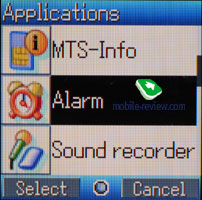
The menu with the most frequently used functions may be called by moving the navi button up. You may form this menu by your wish. Moving down shows a contact list in a phone book. Horizontal moving is similar to using left and right soft-keys and that doesn't seem logical. The same realization is present in Philips 568 that is also made by Quanta.
 Localization is average; there is a word division, strange abbreviations. Predictive text input using T9 dictionary may be used; there are dictionaries for Russian, English and Ukrainian. That becomes a not good tradition of Panasonic.
Phone book. Up to 300 names may be saved in the internal memory, for a name you may have a Name (a field of 18 characters in length), a number (41 symbols), a second number, e-mail address (48 characters), select a picture (both from preinstalled ones or your photos) and also one of the 9 groups may be indicated. The total list shows both numbers from the internal memory and from the SIM-card one. The device makes no difference between these types of numbers and shows it in no way. That may seem a disadvantage for those who got used to keeping numbers not only in the internal memory but on a SIM-card also just as a backup. By the way it's possible only to copy the numbers from your SIM-card to the internal memory but not vice versa. Groups do not provide any personal call melodies or pictures.
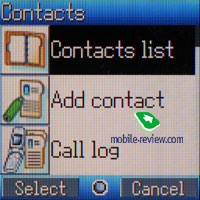 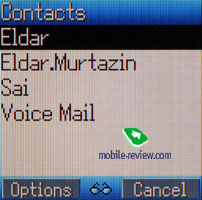
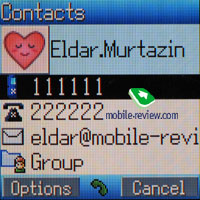 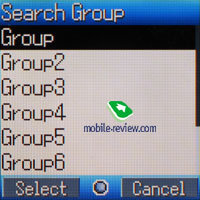
 You may assign numbers for fast dialing to 8 number keys from the phone book menu. Call list is also here (really, there are three separate lists). I liked the fact all the three lists are separated and moving between them is possible by shifting the navi button in a horizontal line. Each list contains up to 10 entries, time and date of the call. If the number is present in the phone book the name and a corresponding image are shown. Separate entries of the phone book may be transferred to other devices via IrDA.
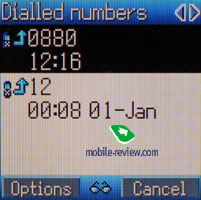 
Messages. Up to 300 SMS may be stored in the internal memory. You may create own templates and use mass mailing lists (but you'll have to select every addressee or type the number in because groups do not work here either). The device doesn't support EMS but the presence of MMS lives it down though partly. The interface for entering a message is rather appropriate but the limitation on the size is 100 KB. Up to 700 KB of memory are available for storing MMS totally.
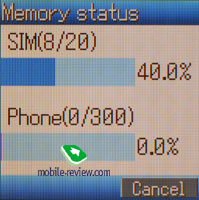 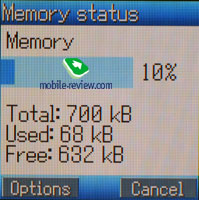
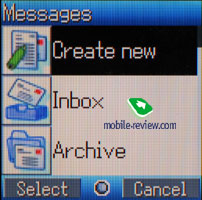 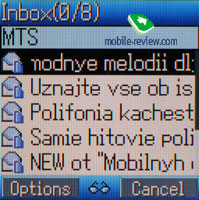
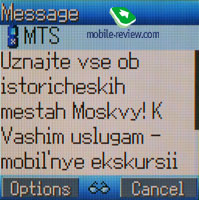 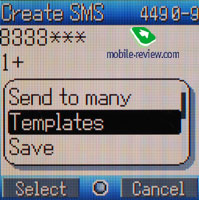 Calendar. You may view up to 5 weeks at the same time, that is some kind of a calendar with a fast shifting to the necessary date. Entering own events is impossible.

WAP. The device supports batch communications GPRS (4+1), wap-browser is version 2.0. In principle there is nothing to say about it.
 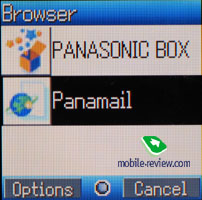
Applications. There is one alarm clock but it may be set once as well as recurrent, there is a possibility to choose a signal and its volume.
  Dictaphone records may last for 14 seconds and have an ARM format; they are stored in a folder named Media.
 The calculator is average without any extra possibilities.
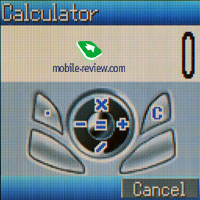 IrDA. The IrDA may be activated from this menu item. The phone can receive pictures, melodies from other devices but can't serve as a GPRS modem.

Media. This menu item hides all the pictures, music and text templates, a general memory condition may be viewed from here.
Games. There is only one game in the phone. That is MobileGolf. Some more games may be downloaded from the PanasonicBox site but other applications seem to be supported.
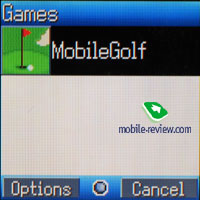 
Settings. Profiles allow selecting the main sound settings for different situations.
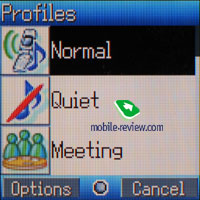  Display. A user may select a screensaver (one of preset pictures), a colour scheme for the menu (5 variants), screen brightness, backlighting working time and turn off keypad backlighting.
 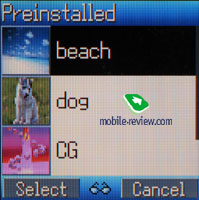
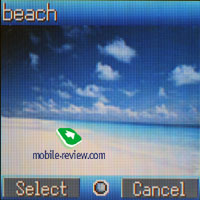 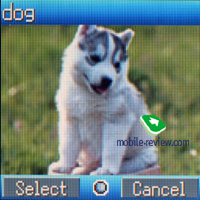
 
 
 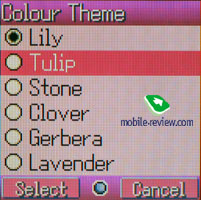
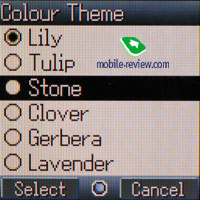 
Camera. There is an integrated VGA-camera with a CMOS matrix. The supported resolutions are 640x480, 352x288 and 160x120 pixels. Contrast level may be adjusted (from -2 to +2) and there is a night shooting mode. That is all for the camera possibilities, the pictures look middling on the screen, and maximum size is about 25 KB.
All the photos in a single file (zip, 220 KB)
 
 Impressions
The phone has 16-tones polyphony and it sounds pleasant but not more. The volume of a call signal is not enough often though monophonic signals are rather loud. The power of the vibrating alert is really low and it may be missed. The device has no any evident problems with the quality of connection and the volume of a loudspeaker. Sometimes frames fall on the zone edges but that is characteristic for the majority of the phones.
 
 
 
The price is the same as for Panasonic X400 and that is about 225 USD now. The manufacturer intends the device as a fashion model. In fact, that is a middle class device with such rivals as Siemens C65, Motorola C650. This phone looks functionally weaker against their background and the only advantage is its design. And that's for you to judge if the design is worth this difference of 50-75 USD.
Sample melodies (mp3, 440 KB)
Links on the topic:
We are grateful to Dixis for the provided device. |





















































